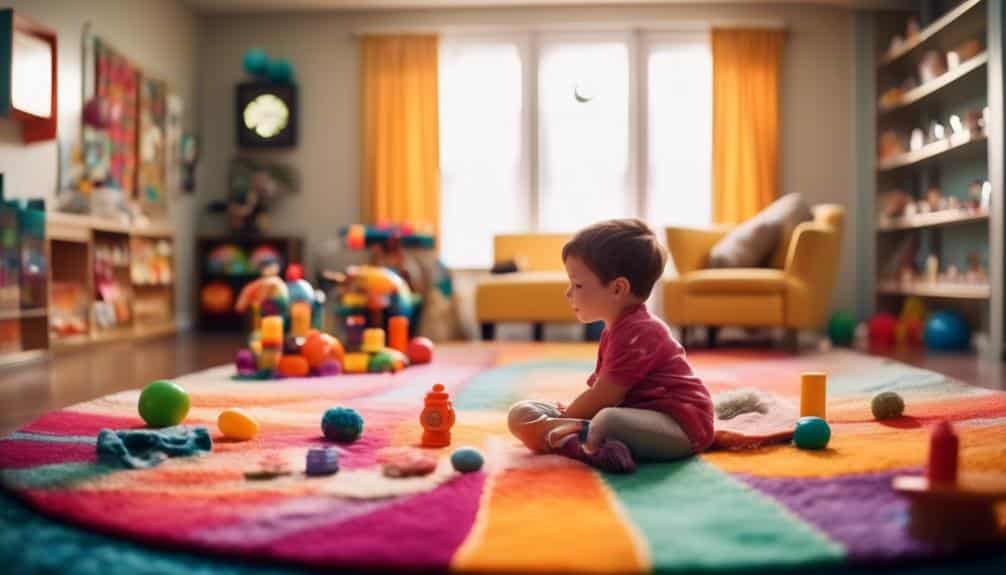Revolutionizing autism therapy, the Developmental, Individual-difference, Relationship-based (DIR) model is a pioneering force with its innovative Floortime intervention approach. This model takes a forefront position in contemporary methodologies dedicated to enhancing developmental outcomes for children with autism spectrum disorder (ASD). By prioritizing emotional and social development through interactive play, DIRFloortime offers a unique and personalized strategy that has garnered attention from clinicians and researchers alike.
The empirical evidence supporting its efficacy presents a compelling case, showcasing significant progress in crucial areas such as social interaction, emotional regulation, and communication among children actively engaged in Floortime therapy. However, as the nuances of individual responsiveness and the ever-evolving landscape of therapeutic strategies for ASD come into consideration, questions arise about optimizing DIRFloortime to maximize benefits across diverse populations. Within this context of inquiry and potential, we direct our attention to the mechanisms that might amplify the effects of this promising intervention, contemplating the implications for the future of autism therapy.
Key Takeaways
- DIRFloortime intervention is grounded in the DIR model and focuses on social-emotional development, tailoring to each child’s needs and strengths.
- The intervention utilizes play therapy training and encourages emotional exchanges, promoting communication and social skills while reducing parental stress.
- Parent involvement and play-based learning are crucial components, as collaboration with family members ensures consistency and reinforcement of therapeutic principles at home.
- Measuring intervention progress and outcomes is done through tools like the Functional Emotional Assessment Scale (FEAS), and research supports the efficacy of DIRFloortime in enhancing the lives of children with developmental disabilities.
Understanding Dirfloortime
DIR/Floortime, an intervention approach grounded in the Developmental, Individual-differences, and relationship-based model, centers on fostering the foundational social-emotional capacities essential for growth in children with Autism Spectrum Disorder (ASD). This developmental approach emphasizes the importance of tailoring interventions to the unique needs and strengths of each child while also engaging them in meaningful interactions that promote their social and emotional development.
Through Floor Time play, therapists and parents are equipped with play therapy training that enables them to interact with children in ways that build upon their natural interests and rhythms. This engagement is critical to enhancing interaction and communication skills, which are often core autism symptoms that children with ASD struggle with. The nurturing of these skills through sensitive and responsive play can lead to meaningful improvements in emotional development among children with ASD.
As an early intervention strategy, DIRFloortime has been supported by robust research, including randomized controlled trials and systematic reviews, which underscore its efficacy in alleviating the challenges associated with ASD. Not only does it offer a compassionate alternative to traditional behavioral therapies, but it also provides a holistic framework for supporting the diverse needs of children with ASD and their families.
Autism Spectrum Engagement Strategies

When considering engagement strategies for individuals on the autism spectrum, tailored play-based interaction offers a dynamic and responsive avenue for growth. By encouraging emotional exchanges, practitioners can foster more profound and meaningful connections, which are central to the developmental progress in communication and social skills. This personalized approach, inherent in the DIRFloortime model, respects each child’s unique preferences and abilities, promoting their overall psychological and emotional well-being.
Tailored Play-Based Interaction
Tailored Play-Based Interaction, an approach that champions customized, playful engagement, stands out as a particularly effective strategy for addressing the intrinsic challenges children on the autism spectrum face in communication, interaction, and relationship-building.
- Holistic Developmental Emphasis:
- DIRFloortime: Integrates individualized, developmental, and relationship-based strategies to enhance communication and social interaction skills.
- Emotional Regulation: Assists children with autism in managing their emotions, leading to more meaningful interactions.
- Parental Involvement: Encourages parents to be actively involved, fostering a supportive environment for the child-focused intervention.
Evidence-based research underscores the efficacy of this cost-effective early intervention, with benefits extending beyond play skills enhancement to nurturing parent-child connections and reducing parental stress, thereby promoting optimal outcomes for children with autism spectrum disorder (ASD).
Encouraging Emotional Exchanges
Fostering emotional exchanges is a pivotal component of engaging children with autism, as it directly influences their ability to relate and communicate effectively with others. DIRFloortime intervention prioritizes these exchanges, enhancing social interaction and communication through a nuanced understanding of each child’s emotional functioning. Early intervention using this method can significantly bolster a child’s social and emotional development.
| Aspect of DIRFloortime | Role in Engagement | Impact on Child |
|---|---|---|
| Emotional Exchanges | Core Focus | Enhances Relationship-building |
| Play Therapy | Medium of Intervention | Fosters Expressiveness |
| Circles of Communication | Develops Reciprocity | Improves Emotion Regulation |
| Emotion Regulation | Builds Capacity to Relate | Supports Overall Emotional Growth |
Methodical and heartfelt, DIRFloortime creates a nurturing environment where children with autism can thrive, emphasizing the importance of emotional exchanges in play therapy for children.
Social-Emotional Development Focus

The social-emotional development focus within DIRFloortime interventions specifically aims to nurture emotional connections and enhance social reciprocity skills among children with Autism Spectrum Disorder (ASD). By creating a supportive environment that attends to the unique emotional experiences of each child, this approach facilitates the emergence of more robust social interactions and emotional bonds. Evidence suggests that such targeted intervention can significantly improve the quality of social engagement and emotional regulation, which are critical components for the overall development and well-being of children with ASD.
Fostering Emotional Connections
Understanding that emotional connections are pivotal for the development of children with autism, DIRFloortime intervention strategically nurtures these relationships, thereby facilitating critical advances in social and emotional competencies. This approach emphasizes:
- Emotional Functioning and Communication:
- Enhancing parent-child relationships
- Reducing caregiver stress
- Encouraging expressive and receptive communication skills
- Social Skills and Emotion Regulation:
- Improving interactive behavior and social responsiveness
- Implementing nature-based play for naturalistic learning
- Cultivating empathy and understanding of social cues
- Early Intervention Outcomes:
- Accelerating development in daily living skills
- Fostering attention and engagement during play
- Promoting sustained progress in children with Autism Spectrum Disorder (ASD)
Enhancing Social Reciprocity Skills
Building upon the foundation of emotional connections and enhancing social reciprocity skills in children with autism becomes a pivotal aspect of DIRFloortime intervention, aiming to elevate their capacity for social responsiveness and meaningful interaction. This systematic approach facilitates the development of crucial communicative competencies and interactive behaviors essential for adaptive behavior and developmental social pragmatic milestones. By engaging in DIRFloortime play therapy, children with Autism Spectrum Disorders experience structured yet flexible learning environments where early intervention can nurture peer interactions and emotional development.
Research substantiates the efficacy of such interventions, observing notable advancements in how these children connect, regulate emotions, and navigate social functioning. Thus, DIRFloortime is a compassionate and informed strategy to enrich the lives of children with ASD through the power of play and reciprocal social engagement.
Individualized Intervention Techniques

Individualized intervention techniques in the context of DIRFloortime are tailored to meet the unique developmental needs and strengths of each child with autism, fostering their ability to relate, communicate, and think. This child-centric model emphasizes the importance of early intervention and actively engages children through play-based therapy, which is critical for their social and emotional development.
The following nested list outlines the core aspects of individualized intervention techniques within DIRFloortime:
- Early Intervention
- Emphasis on identifying and addressing developmental challenges as early as possible, especially for preschool children with autism.
- Provision of support for sensory processing issues to facilitate better engagement with the environment.
- Play-Based Therapy
- Utilization of child-led interactions to encourage spontaneous play that aligns with the child’s interests.
- Integration of activities that promote the expansion of communication skills and emotional sharing.
- Family-Oriented Approach
- Instruction and collaboration with family members to ensure consistency and reinforcement of therapeutic principles at home.
- Awareness and sensitivity to the family’s cultural values and dynamics support a holistic intervention strategy.
Parent Involvement in Therapy

Recognizing the critical role of family dynamics in the developmental journey, parent involvement in DIRFloortime therapy emerges as a cornerstone for enhancing the therapeutic outcomes for children with autism. By engaging in parent training intervention, caregivers learn to use the family-oriented approach of DIRFloortime to play with a child in ways that promote their social and emotional development.
Active involvement in therapy sessions allows parents to observe and practice the techniques that foster communication skills and better interactions with young children with autism. This shared learning experience is vital for early intervention and offers a supportive environment for both the child and the family unit dealing with Autism Spectrum Disorders (ASD).
The table below illustrates the benefits and strategies for parent involvement in DIRFloortime therapy:
| Benefits of Parental Involvement | Strategies for Engagement |
|---|---|
| Improved parent-child relationship | Participate in therapy sessions |
| Enhanced communication & social skills | Implement techniques at home |
| Long-lasting positive outcomes | Reduce parental stress |
Embracing this active role, parents become integral to the therapeutic process, ensuring that the benefits of DIRFloortime extend beyond clinical settings and permeate the child’s everyday life.
Play-Based Learning Applications

While parent involvement lays the foundation for successful intervention, play-based learning applications serve as the vehicle through which children with autism can further develop social responsiveness and interactive behavior. These applications, grounded in methods like DIR/floor time play therapy, are pivotal for enhancing the skills of children on the autism spectrum.
- DIRFloor time Play Therapy:
- *Improves Emotion Regulation*: Children learn to manage their emotions, which is vital for interacting with others.
- *Enhances Social Skills*: Facilitates the development of relationships and communication with peers and adults.
- Play and Language Youngsters (PLAY) Project Home:
- *Early Childhood Development*: Targets the pivotal years of development to enrich the foundational capacities of a child with autism spectrum disorder.
- *Parent Training*: Empowers parents to support their child’s learning and engagement through play.
- Play-Based Learning Applications:
- *Cognitive and Communication Growth*: Play activities are tailored to address specific developmental disabilities while improving social and emotional development.
- *Pretend play*: Encourages imagination, which is crucial in understanding social roles and expectations.
Professionals and caregivers adopting these methods are committed to nurturing the diverse potential of every youngster, recognizing that play is not just an activity but a conduit for meaningful learning and connection.
Measuring Intervention Progress

In assessing the efficacy of DIRFloortime interventions for children with autism, it is critical to track progress in the core areas of relating, interacting, and communicating and evaluate the impact on parental stress and the parent-child relationship. Measuring intervention progress in this context is not solely about observing changes in behavior but involves a holistic approach that encompasses social skills, emotional skills, and the overall developmental trajectory.
The Functional Emotional Assessment Scale (FEAS) is an example of a tool that can chart a child’s growth within the DIRFloortime framework. This scale aids in capturing subtle yet significant shifts in a child’s ability to engage with others and express emotions, which are pivotal in early intervention for autism spectrum disorder.
Moreover, the well-being of caregivers is integral when considering the outcomes of DIRFloortime intervention. Reduction in parental stress indicates an intervention’s positive ripple effects, reinforcing the importance of nurturing the caregiver-child dynamic as a measure of success.
Research, including randomized controlled trials and systematic reviews, substantiates that DIRFloortime intervention can lead to statistically significant enhancements in the lives of children with developmental disabilities. By focusing on these critical indicators, practitioners can ensure that the intervention is effective and supportive of the family.
Case Studies and Outcomes

Building upon the importance of measuring intervention progress, case studies and outcomes further substantiate the efficacy of DIRFloortime in enhancing the developmental capacities of children with autism. The cases reflect various aspects of the treatment’s success:
- Effectiveness in Core Autism Challenges
- Research, including randomized controlled trials, supports DIRFloortime’s impact on relating, interaction, and communication.
- Significant gains in social skills and emotional development have been documented, outperforming traditional behavioral approaches.
- Evidence-Based Practice Recognition
- Systematic reviews have acknowledged DIRFloortime as an EBP, reinforcing its role in the social development of children with ASD.
- Pediatricians increasingly recommend the approach as part of early intervention strategies.
- Parent-Child Communication and Skill Retention
- Case studies demonstrate substantial improvements in the communicative bond between parent and child.
- Noteworthy is the persistence of skill enhancement, evidencing the long-term benefits of DIRFloortime intervention.
The outcomes from these case studies paint a compelling picture for stakeholders in the autism community. They illustrate the tangible progress achievable through DIRFloortime, not only in the immediate treatment period but also in fostering enduring developmental strides for children with autism.
Future Directions in DIRFloortime Research

Exploring the enduring effects of DIRFloortime on individuals with autism, future research aims to shed light on the sustained enhancements in social communication and everyday functional skills. Such studies are critical in expanding the evidence base for this Intervention Program for Young Children, ensuring that DIRFloortime intervention continues to be refined and its efficacy validated through systematic reviews.
The quest for a deeper understanding of the intervention’s impact on the autistic spectrum disorder includes investigating its influence on brain development and neural connectivity. This endeavor is essential for early diagnosis and tailoring interventions to bolster social skills and emotional development.
Incorporating technology and virtual platforms could revolutionize the accessibility and customization of DIRFloortime, providing exceptional opportunities for experimental groups to receive therapy that resonates with their unique needs. Identifying subgroups within the autism spectrum who show heightened responsiveness to DIRFloortime is another avenue for future directions, promoting personalized care and optimizing outcomes.
Moreover, longitudinal research is imperative to illuminate the long-term benefits of DIRFloortime on mental health and familial well-being, transcending symptom management to enhance the quality of life for those touched by autism.
Frequently Asked Questions
How Effective Is DIR/Floortime for Autism?
Floortime for autism is an evidence-based intervention that has been shown to significantly improve social interaction, communication, and emotional development in children with ASD, as evidenced by multiple randomized-controlled studies.
What Is the Most Effective Intervention for Autism?
Determining the most effective intervention for autism requires a personalized approach, considering each individual’s unique needs and responding with evidence-based therapies that enhance communication, social skills, and adaptive behavior.
Why is collaboration among parents, educators, and therapists crucial when employing DIRFloortime techniques?
Collaborating ensures a unified approach, maximizing the effectiveness of DIRFloortime by tailoring interventions to the child’s unique needs across different environments.
How is DIRFloortime revolutionizing autism therapy?
DIR/Floortime transforms autism therapy by customizing play-based strategies, prioritizing emotional connections, and achieving remarkable developmental progress for children on the spectrum.
Conclusion
Autism spectrum disorders can cause mental health challenges, affecting behavior, communication, and social interactions. There are many treatment approaches and intervention programs available to help individuals with autism. Stanley Greenspan, a clinical psychologist, introduced the concept of development and learning as a lifelong learning theory. It emphasizes the importance of developmental capacities and intrinsic motivation.
Intervention for autism spectrum is a comprehensive approach to the autism care landscape. It involves therapies, such as occupational therapy, sensory integrative processing, and behavior modification techniques. The actual service base depends on the developmental stages and needs of the autistic person. Studies show that intervention for children with autism spectrum disorder can improve social interaction skills and developmental challenges in children.
Interventions for individuals with autism can also be used to help adolescents and adults. Alternative communication technologies, such as communication devices, can help individuals with sensory processing disorders. Evidence-based treatment and treatments can help improve emotional development and social relationships. Adults with high-functioning autism can also benefit from intervention programs and actual services. The Journal of Developmental and Learning Disorders suggests using affect-based interactions and educational games to improve the skills of people with autism.
In conclusion, intervention for autism spectrum is an approach to help people with autism thrive in academic, social, and emotional development. It is essential to focus on the actual services base for services, evidence-based practices, and treatments. The Autism Parenting Magazine‘s books and clinical experience for people with autism spectrum disorders are a valuable resource for autism caregivers.


Recent Comments